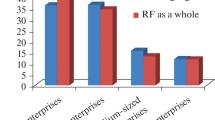Abstract—
The article analyzes regional factors that influence the development of high-tech business in Russia. The empirical basis of the study was the revenue indicators of companies in high-tech and knowledge-intensive sectors in the SPARK database, and regional economic development indicators published by Rosstat. The results of the analysis of the general characteristics of the sampling of companies showed that Russian high-tech business is mainly represented by knowledge-intensive services and is characterized by territorial unevenness. Significant territorial differentiation is also illustrated by the coefficient of regional localization of high-tech business, comparing regional relative indicators with the national value. The impact of regional conditions was assessed by five groups of factors reflecting the “regional profile,” the human resources of the region, its investment potential, scientific and innovative potential, and characteristics of digital infrastructure. Using econometric methods, it has been shown that the development of high-tech business in the region is positively influenced by factors such as a high share of manufacturing in the economy, the availability of personnel with secondary vocational education, the availability of computers for employees, staff involvement in research and development, and technological innovations. According to the calculation results, the characteristics of the scientific and innovative potential have the most significant impact on the high-tech sector.



Similar content being viewed by others
Notes
Statistics Explained. https://ec.europa.eu/eurostat/statistics-explained/index.php?title=Main_Page.
High-tech activity: (1) production of pharmaceutical products; (2) production of office equipment and computers; (3) production of electronic components, equipment for radio, television and communications; (4) production of medical devices; instruments for measuring, monitoring, control, and testing; optical instruments, photo and film equipment; timepieces; (5) production of aircraft, including spacecraft. Medium-tech (high level) activity: (6) chemical production, excluding pharmaceutical products; (7) production of machinery and equipment; (8) production of electrical machines and electrical equipment; (9) production of cars, trailers, and semitrailers; (10) ship construction and repair; (11) production of rolling stock (locomotives, tram cars, etc.); manufacture of motorcycles and bicycles; production of other vehicles and equipment not included in other groups. Knowledge-intensive activity: (12) water transport; (13) aerospace transport; (14) telecommunications; (15) use of computer and information technology; (16) research and development; (17) law, accounting, and auditing; consultations on business and enterprise management; (18) architecture, engineering design, geological survey, and geophysical works, geodesy and cartography, hydrometeorology and related fields, solution of technical problems, not included in other groups; (19) employment and staff recruitment.
The analysis does not include the Nenets Autonomous Okrug (considered part of Arkhangelsk oblast), the Khanty-Mansi and Yamalo-Nenets autonomous okrugs (considered part of Tyumen oblast), the Republic of Ingushetia, where in 2016 no high-tech companies were registered.
Here we consider the lags of return on investment in one and two years.
REFERENCES
Barinova, V.A., Zemtsov, S.P., Semenova, R.I., and Fedotov, I.V., High-tech business in Russian regions: national report. https://www.ranepa.ru/images/News/2018-01/doklad.pdf. Accessed September 3, 2018.
Zemtsov, S.P. and Chernov, A.V., Which high-tech companies in Russia are growing faster and why, Zh. Nov. Ekon. Assots., 2019, no. 1 (41), pp. 68–99.
Kravchenko, N.A., Kuznetsova, S.A., and Yusupova, A.T., Development of innovative entrepreneurship at the regional level, Reg.: Ekon. Sotsiol., 2011, no. 1, pp. 140–161.
Khalimova, S.R., Collaboration of science, education, and business: myths and reality, Reg.: Ekon. Sotsiol., 2019, no. 2 (102), pp. 290–292. https://doi.org/10.15372/REG20190213
Yusupova, A.T. and Khalimova, S.R., Characteristics, development, and regional and sector determinants of high-tech business in Russia, Vopr. Ekon., 2017, no. 12, pp. 142–154.
Breschi, S., Lassebie, J., and Menon, C., A Portrait of Innovative Start-Ups across Countries, Paris: OECD, 2018. https://doi.org/10.1787/f9ff02f4-en. Accessed February 18, 2019.
Cortright, J. and Mayer, H., High tech specialization: a comparison of high technology centers, Brookings Institution, 2001. https://www.brookings.edu/wp-content/uploads/2016/06/specialization.pdf. Accessed February 15, 2019.
Desai, S. and Motoyama, Ya., The Regional Environment in Indianapolis: Insights From High Growth Companies, Kansas: Ewing Marion Kauffman Found., 2015. https://www.kauffman.org/-/media/kauffman_org/ research-reports-and-covers/2015/09/the_regional_ environment_in_indianapolis_insights_from_high_ growth_ companies.pdf. Accessed April 25, 2019.
Du, J. and Bonner, K., Fast-Growth Firms in the UK: Definitions and Policy Implications, ERC Research Paper no. 63, 2017. https://www.enterpriseresearch.ac.uk/wp-content/uploads/2017/12/ERC-ResPap63-DuBonner-Final.pdf. Accessed February 20, 2019.
Goodwin, K., How the location quotient works. https://www.propertymetrics.com/blog/2018/02/19/ location-quotient/. Accessed April 30, 2019.
Hansen, T. and Winther, L., Innovation, regional development and relations between high- and low-tech industries, Eur. Urban Reg. Stud., 2011, vol. 18, no. 3, pp. 321–339.
Hathaway, I., Tech Starts: High-Technology Business Formation and Job Creation in the United States, Kansas: Ewing Marion Kauffman Found., 2013. https://www.kauffman.org/-/media/kauffman_org/ research-reports-and-covers/2013/08/bdstechstartsreport.pdf. Accessed April 25, 2019.
Hi Tech precinct—business case, regional development, 2016. https://www.rdv.vic.gov.au/__data/assets/pdf_file/0009/1409085/160530_Gippsland-Education-and-Innovation-Precinct_FINAL.pdf. Accessed April 25, 2019.
Lagos, D. and Kutsikos, K., The role of IT-focused business incubators in managing regional development and innovation, Eur. Res. Stud., 2011, vol. 14, no. 3, pp. 33–49.
Li, M., Goetz, S.J., Partridge, M., and Fleming, D.A., Location determinants of high-growth firms, Entrepreneurship Reg. Dev., 2016, vol. 28, nos. 1–2, pp. 97–125.
New Technologies and Regional Policy: Towards the Next Cohesion Policy Framework, Brussels: European Union, 2018. https://doi.org/10.2861/413940
Funding
The article was prepared as part of the state task for project XI.172.1.3. “Theory and Methodology of Strategic Management of the Development of High-Tech Business as the Basis for New Industrialization” (no. AAAA-A17-117022250130-8).
Author information
Authors and Affiliations
Corresponding authors
Ethics declarations
The authors declare that they have no conflicts of interest.
Additional information
The article was updated by the authors in 2020 for the publication in Regional Research of Russia.
Rights and permissions
About this article
Cite this article
Khalimova, S.R., Yusupova, A.T. Influence of Regional Conditions on the Development of High-Tech Companies in Russia. Reg. Res. Russ. 10, 308–317 (2020). https://doi.org/10.1134/S2079970520030077
Received:
Revised:
Accepted:
Published:
Issue Date:
DOI: https://doi.org/10.1134/S2079970520030077




